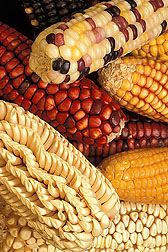This page has been archived and is being provided for reference purposes only. The page is no longer being updated, and therefore, links on the page may be invalid.
| Read the magazine story to find out more. |
|
|
Tapping into Corn's Tropical Diversity
By Dennis O'BrienSeptember 9, 2010
U.S. Department of Agriculture (USDA) scientists are tapping into the genetic diversity of corn from the tropics to improve varieties grown in the United States and other temperate regions.
Corn, or maize, can be traced to tropical Latin America, where the plants flower as the days grow shorter. As maize was carried from tropical to temperate regions, it had to adapt to the longer day lengths found during temperate summers, according to Jim Holland, an Agricultural Research Service (ARS) plant geneticist at the agency's Plant Science Research Unit in Raleigh, N.C. ARS is USDA's principal intramural scientific research agency.
The genetic diversity of tropical maize could be used to improve maize varieties in temperate regions. But because tropical varieties flower very late when grown under long day lengths in temperate climates, undesirable traits such as poor yield can mask favorable traits such as disease resistance, according to Holland.
Holland and his team crossed two tropical, photosensitive maize lines—one from Mexico, the other from Thailand—with two temperate maize lines found in the United States to assess how day length would affect flowering time in the offspring. The lines were added to a collection developed by Holland and other ARS scientists who crossed a commonly studied corn variety with 25 diverse lines and repeatedly self-fertilized the offspring to create 5,000 inbred lines, each with a unique combination of traits. The collection has become a powerful and widely used tool in the search for genes to enhance desirable traits in maize.
Through genetic mapping, Holland's team identified four regions, or quantitative trait loci (QTLs), in the maize genome associated with photoperiod sensitivity. The QTLs—named ZmPR1-4 by the researchers—represent 2 percent of the genetic map, showing that the scientists sufficiently narrowed the genome to pinpoint four specific areas.
The results, published in Genetics, will help researchers select for genes in hardy tropical varieties that could make them better adapted to the long day lengths of temperate regions. They may also help U.S. breeders develop corn varieties that offer increased yields, disease resistance and other desired traits.
Read more about this and other research to improve corn in the September 2010 issue of Agricultural Research magazine.
This research supports the USDA priority of promoting international food security.

